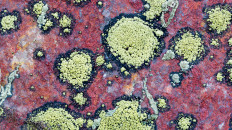
Fungi were classified as members of the plant kingdom until quite late into the 20th century. Today, they are treated as forming their own kingdom, which is phylogenetically more closely related to animals than to plants. Traditionally, mycologists study not only ‘true fungi‘ but also other groups of organisms. Among these are slime moulds and oomycetes, which share many characteristics and life habits with true fungi.

Map lichen (Rhizocarpon geographicum).
Photo: Klaus Bombach
Lichens are symbiotic life forms that typically combine an algal and fungal partner. In some cases, a cyanobacterium replaces the algal partner, in others, both an algal and cyanobacterial symbiont occur in addition to the fungus. Typically, it is the fungus that determines the shape of a lichen. Lichenology and mycology are therefore closely linked. Germany is home to about 2,000 species of lichens as well as an estimated 65,000 species of true fungi and related organisms.
To date, there are valid German Red Lists for mushrooms, slime moulds and lichens. The Red List of phytoparasitic fungi is currently being developed.